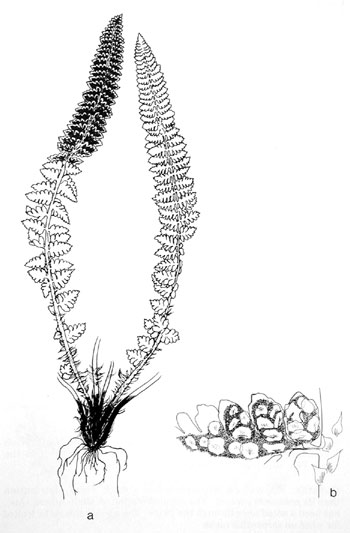|
Hardy Fern Home P. kruckebergii resources
All Ferns � Dryopteridaceae �� Polystichum
�Other Genera
|
| Polystichum kruckebergii | ||
Kruckeberg's holly fern | ||
|
Etymology
Named after botanist and plant ecologist Dr. Arthur Kruckeberg (1920- )
Description
Rhizome: erect, short, sparsely scaly; scales light brown, gradually diminishing in size upwards.
Frond: 35 cm high by 3 cm wide, evergreen, monomorphic or weakly dimorphic, blade/stipe ratio: 4:1 to more usually 10:1. Stipe: grooved, sparesly scaly, vascular bundles: 4 or more, in an arc. Blade: 1-pinnate, lobed pinnae, sometimes pinnatifid, lanceolate, base narrowed, glossy, microscales lanceolate with few projections, confined to costa below. Pinnae: 20 to 40 pair, rhombic-ovate, 0.5--1.5 cm, lower ones lobed at the base, the upper ear well-developed; margins toothed, spiny; veins free, forked. Sori: round, undersides of the upper pinnae, indusium: peltate, central, sporangia: dark brown, maturity: midsummer. Dimensionality: pinnae twisted somewhat out of plane of blade. Culture
Habitat: rocks and cliffs in subalpine to alpine habitats, 2100�3200 m. in California, lower elevations north.
Distribution: western North America.
Hardy to -20�C, USDA Zone 6.
|
|
|
Notes
Compare to distinguished from the common P. lonchitis by the lobed basal pinnae, and from P. scopulinum by the spiny pinnae margins.
Parents probably P. lonchitis and P. lemmonii. The latter is clearly 2-pinnate.
Compare to distinguished from the common P. lonchitis by the lobed basal pinnae, and from P. scopulinum by the spiny pinnae margins.
Parents probably P. lonchitis and P. lemmonii. The latter is clearly 2-pinnate.
